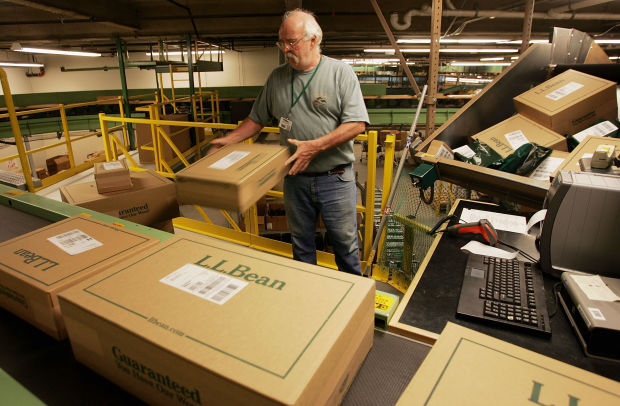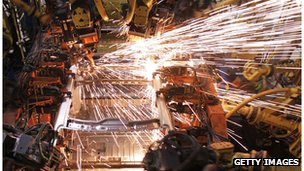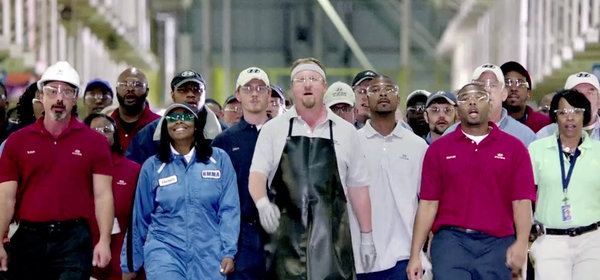Two potentially huge Apple (NASDAQ:APPL) items hit the radar in quick succession over the past few days.
First came rumors that the company was in talks with Intel (NASDAQ:INTC) to replace Samsung as the processor supplier for its mobile devices. Then, as the first shipments of Apple’s new iMac PCs arrived, reports rolled out that at least some of them bore an “Assembled in USA” sticker. CEO Tim Cook rose to prominence at Apple for moving production to China, but could the company be on the verge of a shift back to “Made in America?”
If Intel manages to score the coup of becoming the chip supplier for Apple’s mobile devices, that would be a big story for both Intel and U.S. manufacturing. It was only weeks ago that Apple was supposedly in talks with Taiwanese chipmaker TSMC(NYSE:TSM) about the possibility of replacing Intel CPUs in its PCs with TSMC chips based on ARM (NASDAQ:ARMH) architecture.
Intel CEO Paul Otellini (the guy who brought Apple into the Intel fold but failed to break into the mobile market) retires, and all of a sudden Apple and Intel appear to be making up for lost time. With most of Intel’s chip fabrication plants in the U.S. (including factories in Oregon, New Mexico and Arizona), domestic manufacturing would benefit tremendously. Apple sold 43 million iOS devices last quarter alone — that’s a lot of chips.
Then there’s the story of the “Assembled in USA” iMacs that’s burning up the tech sites right now. Some (but not all) of Apple’s latest iMacs have been arriving on doorsteps adorned with the usual “Designed by Apple in California” message. But instead of “Assembled in China,” they’re marked “Assembled in USA.”
The FTC has very specific rules about how to qualify for that label. To comply, Apple has to be doing much more than just screwing bases onto cases. A factory somewhere in the U.S. has to be building these things.
How could you justify assembling a computer in the U.S. if you can pay ridiculously low wages in China? First of all, those low wages aren’t as low as they used to be. According to The Atlantic,they’re five times what they were in 2000 and expected to continue rising at the rate of 18% per year. At the same time, U.S. labor productivity has risen, while U.S. manufacturing wages over the past five years are now back at the level they were in 2000, adjusted for inflation.
Earlier this year, The New York Times did the math and calculated that if Foxconn workers were paid equivalent U.S wages, it would add $65 to the cost of an iPhone. On a $649 device (the price of a base iPhone 4S at the time) with an estimated materials cost of $203, this would require Apple to either hike prices or bite the difference, cutting into its margins significantly.
However, an iMac is much more expensive. The cheapest is $1,299, so a potential uptick in labor costs may be less noticeable. And then there’s its size.
To get a sense of what it must cost Apple to ship one of these all the way from China, I tried an experiment using FedEx‘s (NYSE:FDX) shipping calculator to compare the cost of shipping a 1.4-pound box (iPhone) and a 42-pound box (27-inch iMac) from Foxconn in Shenzhen to the FedEx hub in Memphis. The result: $448.732 vs. $2,620.72.
Obviously, Apple isn’t paying anything near the rate Joe Public would, and it also uses other shipping companies. But the point is clear.
Shipping an iMac costs six times what it costs to ship an iPhone. If a worker at Foxconn in China ismaking $2.50 an hour compared to an average U.S. manufacturing wage of $19.15 (a difference of $16.65), so long as an iMac took 3.5 hours or so of labor to assemble, Apple would be breaking even by shifting manufacturing back to the U.S. based on the savings in shipping costs.
That’s all hypothetical. But it shows how plausible it is that under current conditions, Apple might shift production of bigger products from China back home. Plus, Apple was facing limited supply of the new iMacs based on problems at Foxconn, so maybe it’s decided to take matters into its own hands. Perhaps a hit on margins is worth the insurance against a hit on revenue if Foxconn can’t keep up.
It doesn’t hurt that the iMac is a relatively low-volume product (compared to iPads and iPhones) and that Apple already has an assembly facility in Elk Grove, Calif., where it built iMacs until 2004 and once employed 1,500 workers. Apple continues to refurbish iMacs for resale at this site, so it retains some technical and distribution capability. As TechCrunch notes, employment at that facility has jumped 50% this year, suggesting something is up.
While it’s possible that Apple merely messed up on its iMac labeling or that Intel Inside iOS devices is wishful thinking on Intel’s part, it’s also possible that between the company’s flagship PC and its determination to free itself from all vestiges of bitter rival Samsung, Apple is shifting toward “Made in America.” If so, here are a few things to watch for:
- Without a doubt, Intel shares would surge. The company has been largely shut out of mobile, and gaining Apple’s business — even if it does so under license from ARM — would immediately vault Intel into a market leader. If it inked a mobile deal with Apple, those rumors about Apple seeking to shift its iMacs and MacBooks away from Intel would likely go away as well.
- Apple’s margins could well take a hit, and even a small decrease could spook investors. Still, computers make up less than a quarter of Apple’s total revenue (and iMacs are a small subset of that), so the actual bottom-line impact of assembling PCs in the U.S. would likely be minimal and may well be offset by “Made in America” goodwill among domestic consumers.
- Shipping companies could actually take a hit from any loss of Apple business. During the iPad 3 launch, for example, it was reported that Apple’s massive shipments form China (at premium rates) boosted the price DHL charged customers for international shipments by 20%. A steady stream of Apple shipments come from China to the U.S., and the vast majority (if not all) is by air.
At the time of writing, Apple hadn’t officially commented on either the “Assembled in USA” iMacs or the Intel talks. Expect all eyes to be on Cupertino for Cook’s response to both. In the meantime, the search is already on for a way to identify the U.S.-assembled iMacs while still in the box, so that consumers can choose them — and send Apple the message that they prefer to buy American.
As of this writing, Brad Moon from http://www.investorplace.com didn’t own any securities mentioned here.
Made in USA Certified: www.USA-C.com











You must be logged in to post a comment.